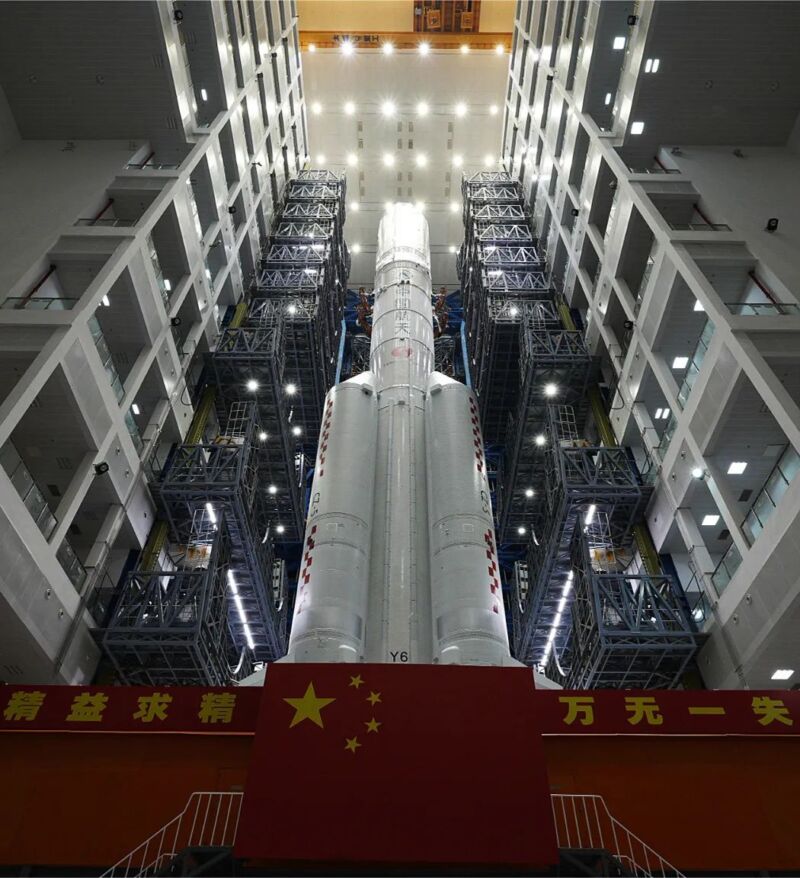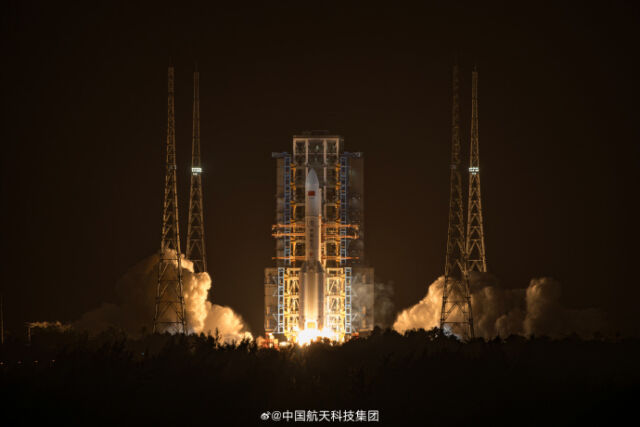STEPHEN CLARK

China's largest rocket apparently wasn't big enough to launch the country's newest spy satellite, so engineers gave the rocket an upgrade.
The Long March 5 launcher flew with a payload fairing some 20 feet (6.2 meters) taller than its usual nose cone when it took off on Friday with a Chinese military spy satellite. This made the Long March 5, with a height of some 200 feet, the tallest rocket China has ever flown.
Adding to the intrigue, the Chinese government claimed the spacecraft aboard the Long March 5 rocket, named Yaogan-41, is a high-altitude optical remote sensing satellite. These types of surveillance satellites usually fly much closer to Earth to obtain the sharpest images possible of an adversary's military forces and strategically important sites.
This could mean a few things. First, assuming China's official description is accurate, the satellite could be heading for a perch in geosynchronous orbit, a position that would afford any Earth-facing sensors continuous views of a third of the world's surface. In this orbit, the spacecraft would circle Earth once every 24 hours, synchronizing its movement with the planet's rotation.
Because this mission launched on China's most powerful rocket, with the longer payload fairing added on, the Yaogan-41 spacecraft is presumably quite big. The US military's space tracking network found the Yaogan-41 satellite in an elliptical, or oval-shaped, soon after Friday's launch. Yaogan-41's trajectory takes it between an altitude of about 121 miles (195 kilometers) and 22,254 miles (35,815 kilometers), according to publicly available tracking data.
This is a standard orbit for spacecraft heading into geosynchronous orbit. It's likely in the coming weeks that the Yaogan-41 satellite will maneuver into this more circular orbit, where it would maintain an altitude of 22,236 miles (35,786 kilometers) and perhaps nudge itself into an orbit closer to the equator.
Staring down from space
In an official statement, China's state-run Xinhua news agency claimed Yaogan-41 will be used for civilian purposes, such as land surveys and agricultural monitoring. In reality, China uses the Yaogan name as a blanket identifier for most of its military satellites.
US military officials will closely watch to see where Yaogan-41 ends up. If it settles into geosynchronous orbit over the Indian or Pacific Oceans, as analysts expect, Yaogan-41 would have a constant view of China, Taiwan, and neighboring countries.
From such a high altitude, Yaogan-41's optical imager won't have the sharp vision of a satellite closer to Earth. But it's easy to imagine the benefits of all-day coverage, even at lower resolution, without China's military needing to wait hours for a follow-up pass over a potential target from another satellite in low-Earth orbit.
In August, China launched a synthetic aperture radar surveillance satellite into a geosynchronous-type orbit using a medium-lift Long March 7 rocket. This spacecraft can achieve 20-meter (66-foot) resolution at Earth's surface with its radar instrument, which is capable of day-and-night all-weather imaging.
Optical payloads, like the one on Yaogan-41, are restricted to daytime observations over cloud-free regions. China launched a smaller optical remote sensing satellite into geosynchronous orbit in 2015, ostensibly for civilian purposes.
Although Chinese officials did not disclose the exact capabilities of Yaogan-41, it would almost certainly have the sensitivity to continually track US Navy ships and allied vessels across a wide swath of the Indo-Pacific. Aside from its use of the larger payload fairing, the Long March 5 rocket used to launch Yaogan-41 can haul approximately 31,000 pounds (14 metric tons) of payload mass into the orbit it reached on Friday's launch.
This suggests China could have equipped Yaogan-41 with a large telescope to stare down from space. Notably, China acknowledged Yaogan-41's purpose as an optical imaging satellite. China's government doesn't always do that. Perhaps this is a signal to US officials.
China's Long March 5 rocket lifted off with the Yaogan-41 spy satellite at 8:41 am EST (13:41 UTC) Friday.
The Pentagon now sees the United States in strategic competition with China, particularly after US intelligence officials reported that Chinese President Xi Jinping had instructed his military to be ready to invade Taiwan by 2027. There are doubts among US and Taiwanese officials that China will attempt a takeover of Taiwan as soon as four years from now, but US Space Force officials say they are focused on preparing for a fight.
Such a conflict would inevitably extend into space, with Chinese and US forces reliant on satellite functions for communication, navigation, reconnaissance, and command and control.
“We must be ready for a kind of war we have no modern experience with,” Secretary of the Air Force Frank Kendall said in September. After decades of emphasizing defense against terrorism, Kendall said the US is now in a competition among "great powers."
“The threat of attack from violent extremist organizations still exists, and we will address those threats as they occur. But China is by far our pacing challenge,” Kendall said. “China has been reoptimizing its forces for great power competition and to prevail against the US in the Western Pacific for over 20 years. China has been building a military capability specifically designed to achieve their national goals, and to do so if opposed by the United States."
Chief Master Sgt. Ron Lerch, the senior enlisted leader of the Space Force's intelligence directorate, briefed attendees of the Space Force Association's first annual Spacepower Conference on China's growing space capabilities this week in Orlando, Florida.
Lerch said China has launched an "eye-watering” number of spy satellites. One of his charts indicated China has 198 satellites for Earth-imaging to gather intelligence and provide military reconnaissance data, compared to just 11 for Russia. Most of these satellites have launched in the last few years as China has ramped up its launch rate, so there's a lot of new data flowing from space to intelligence processing centers in China.
“With that much kit on orbit, one of the popular questions I get asked is, are the Chinese, especially the PLA (People's Liberation Army), are they sort of drowning in data?" Lerch said. The answer to that question, he said, is no.
China has two new military services: A Rocket Force that Pentagon officials claimed is focused on developing ways to attack airfields and aircraft carriers, and a Strategic Support Force to achieve "information dominance in the space and cyber domains," Kendall said in September. Lerch said this support service offers a robust labor force for the Chinese military to process and disseminate intelligence from the country's spy satellite fleet.
In his presentation Tuesday, Lerch highlighted the cost-effectiveness of the Long March 5 rocket, the type of launcher used for Friday's launch with Yaogan-41. Although the rocket is an expendable design, Lerch said the marginal cost to launch a kilogram of payload mass on a Long March 5 is $3,000.
"The Long March 9, which they are hoping to leverage reusable technology towards the turn of the decade, when that’s operational, they’re hoping to shave that in half to about $1,500 per kilogram," Lerch said. "The Chinese are going that route ... and they’re going to get there with different types of fuel and also through reusability.”
Friday's Long March 5 flight with Yaogan-41 was the country's 61st orbital launch of the year. It came one day after China launched a top-secret military spaceplane on a smaller Long March 2F rocket.
“The Chinese, they’ve put a lot of satellites into orbit, they’re putting a lot of things up," Lerch said. "But the reality is how durable, how sustainable are those systems? We don’t know yet. The jury is still out on that.”

No comments:
Post a Comment